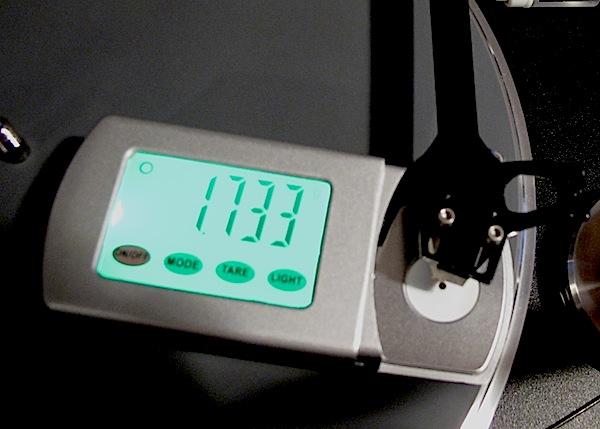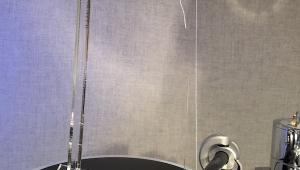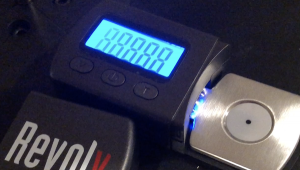What's the best way to test a digital scale to see if it's magnetic? My scale (which looks similar to the one above) will show a negative reading when a moving coil cartridge is hovering just above the surface of the scale. Does this mean it's magnetic?
Audio Additives Digital Stylus Force Gauge
Most of these units look similar but they are not all identical. There are a few things you should look for when buying one. For starters, make sure the one you choose is not magnetic. There are some out there that are, which means it will attract the cartridge and at best give you an inaccurate reading. At worst, use your imagination. Also make sure the one you're considering reads the VTF (vertical tracking force) close to the platter surface. Ideally it should approximate record height when no record is on the platter.
Why is that important? Tonearms come in three three balance flavors: "stable" "neutral" and "negative". A "stable balance" arm is one where the center of gravity of the moving system is located below the pivot point. That's true with most unipivot arms, where the lower center of gravity aids stability. A "negative balance" tonearm is one where the center of gravity is above the pivot point, and a "neutral balance" arm is one in which the center of gravity is in line with the pivot point.
If your tonearm is "stable balanced," the further from the record surface you measure tracking force, the less accurate will be your result. That's because a "stable balanced" arm wants to return to its resting position on the record surface. The further up from the record surface you measure the tracking force the greater will be the measured force because the arm wants to return to its resting point on the record surface.
In practical terms that means if you measure 2 grams well above the record surface, the tracking force will be lower and perhaps too low at the record surface. That is one reason the simple Shure "teeter-totter" device is not accurate with "stable balanced" arms.
A "negative balanced" arm means the higher up you measure VTF the lower will be the tracking force at the record surface. A "neutral balanced" arm doesn't care where you measure VTF. It will remain the same high or low.
If you have a unipivot arm like a VPI, Kuzma Stogi S, or pre "Magneglide™" Graham arms, it will be "stable balanced". Kuzma's 4 Point is negative balanced. Most gimbaled arms close to neutral balance. Graham's Phantom Supreme is neutral balanced. Each of these balance conditions produces different results under dynamic conditions such as when encountering a warp, but that's best discussed in a tonearm review.
For now let's just say measuring close to the record surface is a good idea regardless of your particular arm's balance. You can find out which your arm is by measuring VTF at the record surface and a few inches above. If the arm is neutral balance, you'll get the same result.
Back to the Audio Additives stylus force gauge! It is non-magnetic, measures close to the record surface, and is good to 3 decimal points. It also comes with a 5 gram weight that can be used to calibrate the scale, though it comes calibrated and should not need adjusting. It's powered by 2 included 'AAA' batteries, which is also good because they are less expensive and more readily available than the "button" type batteries found in some scales. The backlight automatically shuts off within 20 seconds and the entire unit shuts down within a minute.
The instructions tell you to use the supplied philips head screwdriver to remove the battery cover and install the batteries, but the batteries come pre-installed. However the terminals are plastic protected to keep the batteries fresh so open the battery covers, remove the batteries and peel off the plastic covers.
I found the Audio Additives to be accurate, reliable, easy to use and just as easy to recommend. If you have a spring suspended turntable, be sure to let it come to a rest after you place the scale on the platter or it won't set to 000 and be ready to use.
- Log in or register to post comments


When the cartridge is above the platform I get a negative reading that becomes more negative the closer I get to the platform, reaching up to about .1g. Neither the body or the platform are magnetic (I checked) but of course the AA batteries are. This was not a problem with the older plastic bodied unit (IIRC the flat batteries were on the far side of the case) but seems to be a problem here. Now why the platform is pulling up because of this is beyond me.
What I have done is check the VTF at record height on a platform next to the platter and also check it with a lip balm cap in the center of the platform with a shorter platform (and still at record height). Directly on the platter it reads about .03g -.04g higher than on the cap. I assume the slight magnetic pull from the batteries is somehow causing this. With some cartridges this might not make a difference but with mine it does. The old plastic gauge (which was as accurate as this one is) read the same as the new gauge with the lip balm cap so that is what I use now.
A penny weighs the same whether directly on the platform or on the lip balm cap and I have marked the middle of the cap with a dot to place the stylus on. If the cap is not in the middle of the platform and the stylus is not on the dot in the middle, you will get slightly different readings, same as you would when getting readings directly on the platform.

...but sold in the UK as 'Analogue Studios'. http://www.amazon.co.uk/Precision-Digital-Stylus-Force-Gauge/dp/B007LNX2...

i have the AA, and have found a slight variation in the reading depending on where I place the gauge- near the outer rim, or closer to the center. is this expected?

I use this scale to set up my carts:
http://dx.com/p/digital-precision-scale-with-leather-case-5g-max-0-01g-r...
It's essentially the same scale as the Audio Additives, except it only goes to 2 decimals. That said, it's also only $14.64 shipped. Works really well and you can use the savings to buy vinyl. I have no affiliation with the online merchant linked to here, just hate to see audiophiles, including myself, separated from their money any more than necessary.

Yep, it comes with a calibration weight. I also used a coin to double check calibration--can't remember which one off the top of my head (nickel or something), but it has a known weight that was accurately read by the scale.

I think I read about these scales on VinylEngine a couple of years ago and ordered one. I love it. No need to spend $80. Also it was recommended to buy this calibration weight. http://dx.com/p/professional-precision-digital-scale-5g-calibration-weig...
Nothing better than getting really cool stuff like this for cheap and you can't feel too bad since the more expensive model is made in China also. I've heard we can thank the illegal drug trade for very accurate and cheap scales. 

I'm "remembrancing" in the white powders' currency of the past, since Mr. living didn't do any.

Ordered one to pair with another model one I already got, at this price it's a no brainer. Had the same one sold to me from a dealer for $80.00 few years ago so thanks for sharing.

to have gotten a good one. Many were junk because they suffered from overly aggressive battery appetites. It could deplete a new set of batteries within hours, even though powered off.

not neutrally balanced, but stable balanced, albeit many are very close to being neutral. The only true neutral balanced arms in my experience are the Graham Phantom and the arm on original Acoustic Research turntable of the early sixties.

Aside from the VTF effects contributed by stable, neutral and balanced tonearms, I'd think that you'd see the highest VTF reading at level and the VTF should decrease as you move away from 0 degrees and approach either 90 or 270, because the pivot bears an increasing amount of weight in either a pull or push mannger so I disagree that height does not make a difference in that regard. Also, I don't think setting the gauge on the platter is sufficient. It's tray is high enough off to account for a .3 gm higher difference (due to my unipivot stable characteristic). Therefore I measure level with the record using a block of wood next to the platter on which I rest the gauge. Credit goes to HW on the VPI site for making sure you take the reading at the level of the record. I used a medium thickness record.
Also, I have this same gauge. Sometimes I find it's necessary to take several readings and take an average since they vary sometimes, even with the needle in the center of the dot. I've also noticed the mere presence of the cartridge hanging above the tray will cause a small reading.

Call me dumb...not sure I understand the explanation on the tonearms types "stable, neutral, negative" ..........I have a Pro-ject 9c arm.
I always measure VTF at playing height and about the middle of the LP.

Are the VTF markings on most counterweights generally innaccurate?

On my Jelco SA-750D tonearm as well as my older FT-4, the dial on the TF weight is off .3 gms or more. Both are way off.
One can listen for setting it manually, but you really need to know what is right or how it supposed to sound from past experience of that exactly cartridge sounds. But even that will lead to inaccuracies of .1 gms, which isn't terrible, but not right.

Appreciate the links to the lower-dollar unit, worth a try for sure!

My experience at this point is to read the tracking force at the same level/size of a LP. Non magnetic gauge is also a must.
These couple of points are MUCH important than any others (e.g. 0.001 precission)

Maybe no one will read this but I should still mention, over a 6 weeks ago I took Rischa's advice from above and ordered one from dx.com. It is now April 23, and still no gauge, customer service is a laugh with a complete run around. DO NOT ORDER FROM THEM! Pay a little more and get it locally.

I bought one of these from Music Direct and it works but I have to take the batteries out after each use. If I leave them in, even powered off, the batteries will be drained next time. I now leave the battery covers off permanently and just pop in two batteries every time I need to check the VTF. A pain but it works. I wonder if there really is any difference between this $79 purchase and the cheapo models one finds on Ebay.

I have the same problem many have mentioned that as soon as the cartridge starts approaching the scale negative wt numbers start showing up. This is due to the magnetic field of the cartridge pulling on the scale. You resolve this by getting the stylus as close to the scale as you can w/o the stylus touching the scale and use the TARE function to zero the wt. Then you can proceed to lower stylus into the scale for an accurate reading.

And correct. The tare and the 5gm calibration are spot on and repeatable.


Here is another Gauge, %26.50 on Amazon it can be calibrated also.
https://www.amazon.com/Riverstone-Audio-Precision-Turntable-Resolution/d...


I know this is an old thread, but I thought I would toss in my own two cents.
#1. It is a myth to say that a magnetic platform will affect the reading. You can weigh an actual magnet accurately on a magnetic gauge. Yes, you will get a negative reading when the cartridge is supported above the measuring platform, but this is because the arm and cartridge are being supported by the cueing device or your finger. As soon as the stylus is lowered onto the platform and the entire downward pressure of the stylus is acting on the measuring platform, the upward force of the cueing device is no longer affecting the reading.
#2. The measuring platform height is critical. I did some tests using a VPI Fatboy arm, and just by removing the thin VPI felt mat, the reading would change by almost 0.2 grams. A larger change, similar to the thickness of the low cost digital gauges people often use, would alter the reading by as much as half a gram! The Kuzma 4Point is also seriously affected by measuring height.
#3. Some arms will vary the stylus pressure as they play from the start to the end of the side. It is important to measure in a couple of different spots.
I really like the Riverstone Audio Record Level gauge mentioned in another comment. It's measuring platform can be tweaked so it's exactly at the record height, and even altered for 180G vs regular pressings. I have been using one daily for almost three years, and it has been utterly reliable. Plus, it's only $29.

I didn't make it clear that I only meant to say that it doesn't affect the reading if the measuring platform itself is magnetic. Any other magnetic materials in the fixed part of the gauge can certainly affect the reading.

I found that the weighting platform is not as responsive or as accurate as this Audio Additives gauge. The same holds true to a lesser extent for the Riverstone Audio TF gauge I own as well. Both are consistently off .1gms compared to the AA gauge here.
The readout also has a steady circle that notes when the weighing of a cart had rested and holding a stable read. This can show you precisely when the TT suspension has come to a rest. After years of close but not really, this is my new standard for measurement. It's also on sale frequently with a web search.

As I just saw online. 31% off is nice.











































